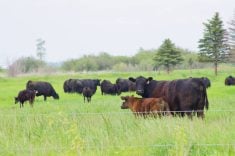LANIGAN, Sask. – There is no average cattle producer in Saskatchewan but there are some operating cost benchmarks that growers can look at when comparing themselves to others in the cow-calf industry.
Kathy Lang of the Western Beef Development Centre in Humboldt, Sask., said five years of data from roughly 100 producers is helping WBDC understand the production systems used by cow-calf producers.
For example, in 2005, it took 235 days to rear a feeder-market-ready animal of 565 pounds. In addition, Saskatchewan producers have a 93 percent weaning average, meaning that out of every 100 calves born, 93 survive to weaning.
Read Also

House ag committee to undertake several studies
The House of Commons standing agriculture committee has set its agenda for the coming months. Members began the fall sitting with a two-hour update on international trade
The organization finds that there are high-cost and low-cost producers who are differentiated by their production techniques and the amount of depreciation being taken on equipment and buildings.
“The same folks that have more equipment and higher facilities costs are the ones with earlier calving and higher winter feeding costs,” Lang said.
These producers also tend to keep some purebred cattle and have depreciation costs of about $23 per cow.
Lower cost producers have smaller, current investments in infrastructure and tend to swath or post-grain harvest graze and have a per head depreciation of $11 per cow.
“Location wasn’t the factor you might think it might be. There are low and high-cost producers spread across the province,” Lang said.
In the study, the 25 percent of producers with the lowest cost of production had an average cost of $433 per cow and an average herd size of 382 animals.
The remaining 75 percent had a cost of production of $629 per cow and a smaller herd of 229 cows.
Low-cost producers averaged a per cow margin of $222 per cow after direct fixed and operating expenses, while their higher-cost neighbours received $118 per animal.
Overall in Saskatchewan, cow-calf producers averaged an enterprise profit of $70 per calf marketed in 2005.
Calves brought $1.24 per pound.
The study also found that 32 percent of cow-calf producers have off-farm employment, 32 percent employ labour, 64 percent have an operating partner and are likely in some form of family succession arrangement and 36 percent are between 25 and 35 years old.
The WBDC is looking for producers to volunteer to be part of a similar study in 2006.
In exchange for their participation, growers receive the WBDC’s economic analysis of their operation.
WBDC senior scientist Bart Lardner said participants who took part in the study felt it was beneficial.
“Participants tell us they get a lot out of the process and the results. It can be very illuminating when it comes to figuring out their true costs and where they might become more efficient,” he said.
Lang added that there is a lot variability in the systems of production used in Saskatchewan.
















